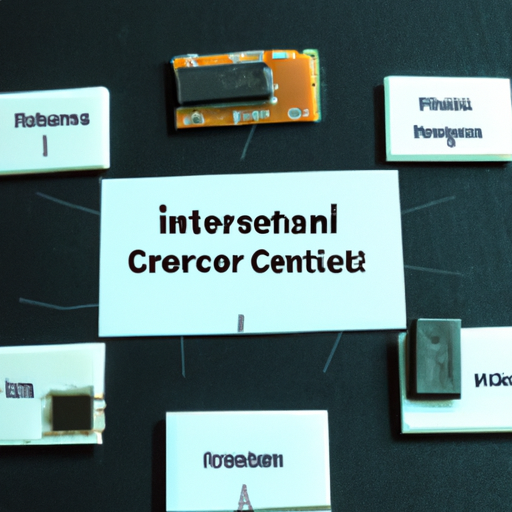Title: Exploring the Key Product Categories of Integrated Circuits (ICs)

1. Microprocessors and Microcontrollers (200 words) Microprocessors and microcontrollers are perhaps the most well-known product category of integrated circuits. These chips serve as the brains of electronic devices, executing instructions and performing calculations. Microprocessors are commonly found in computers, smartphones, and other consumer electronics, while microcontrollers are used in embedded systems, such as home appliances, automotive systems, and industrial machinery.
2. Memory ICs (200 words) Memory integrated circuits are responsible for storing and retrieving data in electronic devices. They come in various forms, including read-only memory (ROM), random-access memory (RAM), and flash memory. ROM chips store permanent data, such as firmware and software instructions, while RAM provides temporary storage for data that can be read from and written to. Flash memory, on the other hand, offers non-volatile storage, making it ideal for portable devices like USB drives and solid-state drives (SSDs).
3. Analog ICs (200 words) Analog integrated circuits process continuous signals, such as sound, temperature, and voltage, and convert them into digital or analog outputs. These chips are crucial in applications where precise measurements and control are required, such as audio amplifiers, power management systems, and sensor interfaces. Analog ICs play a vital role in bridging the gap between the physical world and digital systems.
4. Digital ICs (200 words) Digital integrated circuits manipulate discrete signals represented by binary digits (bits). They perform logical operations, such as arithmetic calculations, data storage, and signal processing. Digital ICs are widely used in digital signal processors (DSPs), field-programmable gate arrays (FPGAs), and application-specific integrated circuits (ASICs). These chips are the backbone of modern computing systems, enabling high-speed data processing and complex computations.
5. Power Management ICs (200 words) Power management integrated circuits regulate and control the power supply in electronic devices. They efficiently convert and distribute power, ensuring optimal performance and energy efficiency. Power management ICs are commonly found in smartphones, laptops, and other battery-powered devices, as well as in power supplies, motor control systems, and renewable energy systems.
6. Communication ICs (200 words) Communication integrated circuits facilitate the transmission and reception of data and signals across various communication channels. These chips enable wireless communication, networking, and connectivity in devices like smartphones, routers, and modems. Communication ICs encompass technologies such as Wi-Fi, Bluetooth, NFC (Near Field Communication), and cellular communication, enabling seamless data exchange and connectivity.
Conclusion (100 words) Integrated circuits have transformed the world of electronics, enabling the development of smaller, faster, and more efficient devices. This article has explored the key product categories of integrated circuits, highlighting their diverse applications and the impact they have on various industries. From microprocessors and memory ICs to analog and digital ICs, these tiny electronic components are the backbone of modern technology. As technology continues to advance, integrated circuits will play an increasingly vital role in shaping the future of electronics and driving innovation across industries.
Title: Exploring the Key Product Categories of Integrated Circuits (ICs)

1. Microprocessors and Microcontrollers (200 words) Microprocessors and microcontrollers are perhaps the most well-known product category of integrated circuits. These chips serve as the brains of electronic devices, executing instructions and performing calculations. Microprocessors are commonly found in computers, smartphones, and other consumer electronics, while microcontrollers are used in embedded systems, such as home appliances, automotive systems, and industrial machinery.
2. Memory ICs (200 words) Memory integrated circuits are responsible for storing and retrieving data in electronic devices. They come in various forms, including read-only memory (ROM), random-access memory (RAM), and flash memory. ROM chips store permanent data, such as firmware and software instructions, while RAM provides temporary storage for data that can be read from and written to. Flash memory, on the other hand, offers non-volatile storage, making it ideal for portable devices like USB drives and solid-state drives (SSDs).
3. Analog ICs (200 words) Analog integrated circuits process continuous signals, such as sound, temperature, and voltage, and convert them into digital or analog outputs. These chips are crucial in applications where precise measurements and control are required, such as audio amplifiers, power management systems, and sensor interfaces. Analog ICs play a vital role in bridging the gap between the physical world and digital systems.
4. Digital ICs (200 words) Digital integrated circuits manipulate discrete signals represented by binary digits (bits). They perform logical operations, such as arithmetic calculations, data storage, and signal processing. Digital ICs are widely used in digital signal processors (DSPs), field-programmable gate arrays (FPGAs), and application-specific integrated circuits (ASICs). These chips are the backbone of modern computing systems, enabling high-speed data processing and complex computations.
5. Power Management ICs (200 words) Power management integrated circuits regulate and control the power supply in electronic devices. They efficiently convert and distribute power, ensuring optimal performance and energy efficiency. Power management ICs are commonly found in smartphones, laptops, and other battery-powered devices, as well as in power supplies, motor control systems, and renewable energy systems.
6. Communication ICs (200 words) Communication integrated circuits facilitate the transmission and reception of data and signals across various communication channels. These chips enable wireless communication, networking, and connectivity in devices like smartphones, routers, and modems. Communication ICs encompass technologies such as Wi-Fi, Bluetooth, NFC (Near Field Communication), and cellular communication, enabling seamless data exchange and connectivity.
Conclusion (100 words) Integrated circuits have transformed the world of electronics, enabling the development of smaller, faster, and more efficient devices. This article has explored the key product categories of integrated circuits, highlighting their diverse applications and the impact they have on various industries. From microprocessors and memory ICs to analog and digital ICs, these tiny electronic components are the backbone of modern technology. As technology continues to advance, integrated circuits will play an increasingly vital role in shaping the future of electronics and driving innovation across industries.